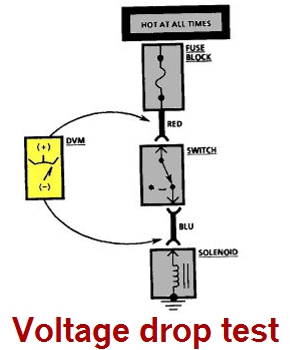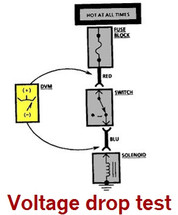Posted by Support Staff on 17th Apr 2017
How to perform a Voltage drop test
This test checks for voltage being lost along a wire, or through a connection or switch. (see diagram below)
- Connect the positive lead of a Digital Voltmeter (DVM) to the end of the wire (or to one side of the connection or switch) which is closer to the Battery.
- Connect the negative lead to the other end of the wire (or the other side of the connection or switch).
- Operate the circuit.
- The Digital Voltmeter will show the difference in voltage between the two points.
Typical voltage drop maximums:
- Battery post to battery terminal = 0 volts
- Main (-) cable to engine block = 0.20 volts
- Engine to body (-) Ground strap = 0.20 volts
- Battery (+) main cable (end to end) 0.20 volts (This main connect to the starter or Buss, depending on year, make and model)
- Battery post (+) to alternator battery (+) bolt = 0.5 volt with maximum charging load applied (all accessories on)
- Battery post (-) to alternator metal frame = 0.20 volt
- starter circuit (including starter solenoid) = 0.60 volts
- starter solenoid = 0.20 volts
- Battery Negative (-) Post to metal starter body = 0.30 volts
Voltage drop readings that exceed the above standards indicate a problem that needs further investigating.




